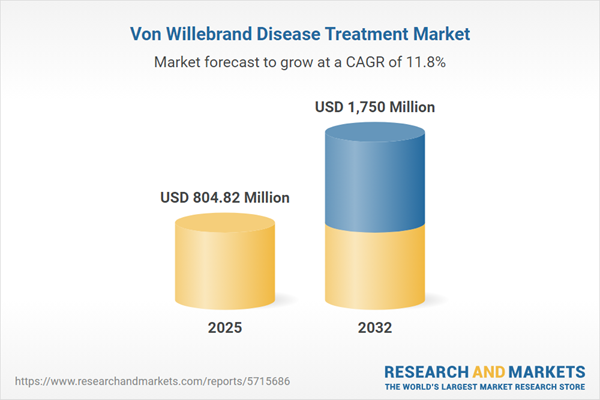Speak directly to the analyst to clarify any post sales queries you may have.
Senior executives navigating the rare disease pharmaceutical sector require robust, reliable insights to address shifting patient demands, operational pressures, and evolving compliance frameworks. The Von Willebrand Disease Treatment Market presents both opportunities and challenges, making accurate market intelligence essential to informed leadership and competitive strategy.
Market Snapshot: Von Willebrand Disease Treatment Market Overview
The Von Willebrand Disease Treatment Market is on a trajectory of steady growth, shaped by the increasing use of biologic and recombinant therapies. These advancements signal a move toward more individualized treatment protocols and reflect broader trends in targeted care. The integration of personalized medicine and digital health solutions is influencing healthcare infrastructure, while organizations navigate a landscape defined by complex global regulations and varying reimbursement models. A rise in clinical expectations is prompting companies to adapt their operational and strategic approaches to succeed in this environment.
Scope & Segmentation: Strategic Dimensions of the Von Willebrand Disease Treatment Market
This report delivers actionable analysis on the main forces shaping the Von Willebrand Disease Treatment Market, supporting senior decision-makers in developing agile, regional, and global strategies. Market segmentation covers the most relevant therapeutic, clinical, and operational dimensions:
- Product Types: Includes desmopressin, tranexamic acid, aminocaproic acid, plasma-derived concentrates, and recombinant concentrates, supporting both acute intervention and chronic management strategies in alignment with precision medicine initiatives.
- Treatment Types: Features both on-demand regimens and prophylactic protocols, facilitating adaptability in responding to variable clinical requirements across patient populations.
- End Users: Comprises specialty clinics, outpatient centers, hemophilia units, public hospitals, and private hospitals, each emphasizing digital integration and streamlined care delivery models to advance patient outcomes.
- Distribution Channels: Spans hospital pharmacies, retail pharmacies, and digital platforms, expanding market access and improving the speed and reliability of therapy delivery in established and emerging healthcare settings.
- Severity Profiles: Encompasses Type 1, Type 3, and all Type 2 variants (2A, 2B, 2M, 2N), requiring distinct clinical approaches to accommodate diverse patient cohorts.
- Geographies: Considers North America, South America, Europe, Asia-Pacific, Middle East, and Africa, each presenting unique healthcare infrastructure needs, reimbursement landscapes, and policy environments that shape market strategy.
- Leading Companies: Highlights sector leadership by organizations such as CSL Limited, Takeda, Octapharma, Grifols, LFB, Kedrion, Bio Products Laboratory, and Biotest AG, recognized for broad pipelines, compliance rigor, and collaborative initiatives.
Key Takeaways for Senior Decision-Makers
- Adoption of integrated care models is tightening coordination among payers, product manufacturers, and healthcare providers, delivering more cohesive patient management for rare bleeding disorders.
- Emergent technologies, including extended half-life therapies and gene-based approaches, are advancing clinical practice and offering greater flexibility for care personalization.
- Varying regional policies and evolving regulatory structures are directly influencing go-to-market planning, incentivizing data-driven resource allocation and careful market entry selection.
- Partnerships with patient advocacy groups are expediting access to innovative therapies while aligning product development with real-world patient priorities.
- Supply chain resilience remains a primary concern, with enhanced supplier relationships and operational flexibility supporting consistent therapy access as external risks change.
Tariff Impact and Supply Chain Adaptation
The introduction of new U.S. tariffs on hemostatic and replacement therapies compels organizations in the Von Willebrand Disease Treatment Market to reassess supply chain frameworks. To limit volatility and operational exposure, key industry players are increasing domestic manufacturing capabilities, building long-term supplier alliances, and proactively engaging with regulatory agencies and payers. These adaptive measures ensure continuity of patient care and reinforce network resilience, even as trade policy and tariff structures evolve.
Methodology & Data Sources
The report’s findings are derived from structured interviews with clinical specialists, payers, advocacy leaders, and supply chain managers. This primary research is strengthened by peer-reviewed publications, advanced economic modeling, and rigorous validation using trusted third-party data and systematic cross-referencing techniques.
Why This Report Matters
- Equips executive teams with intelligence to anticipate regulatory shifts, adjust to reimbursement trends, and align operations with current Von Willebrand Disease Treatment Market realities.
- Enables accurate risk-aware planning and targeted strategy development across various regions and operational environments.
- Facilitates evidence-based decisions, empowering businesses to respond swiftly to sector changes and leverage emerging opportunities.
Conclusion
This analysis positions senior decision-makers to meet evolving market challenges, execute efficient strategies, and achieve sustainable growth as the rare disease treatment landscape develops.
Additional Product Information:
- Purchase of this report includes 1 year online access with quarterly updates.
- This report can be updated on request. Please contact our Customer Experience team using the Ask a Question widget on our website.
Table of Contents
3. Executive Summary
4. Market Overview
7. Cumulative Impact of Artificial Intelligence 2025
List of Figures
Companies Mentioned
The companies profiled in this Von Willebrand Disease Treatment market report include:- CSL Limited
- Takeda Pharmaceutical Company Limited
- Octapharma AG
- Grifols, S.A.
- Laboratoire Français du Fractionnement et des Biotechnologies
- Kedrion S.p.A.
- Bio Products Laboratory Limited
- Biotest AG
Table Information
| Report Attribute | Details |
|---|---|
| No. of Pages | 184 |
| Published | November 2025 |
| Forecast Period | 2025 - 2032 |
| Estimated Market Value ( USD | $ 804.82 Million |
| Forecasted Market Value ( USD | $ 1750 Million |
| Compound Annual Growth Rate | 11.8% |
| Regions Covered | Global |
| No. of Companies Mentioned | 9 |









